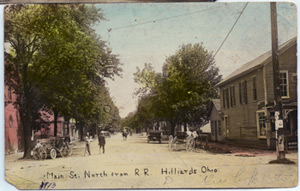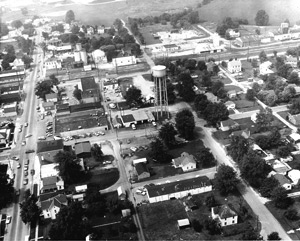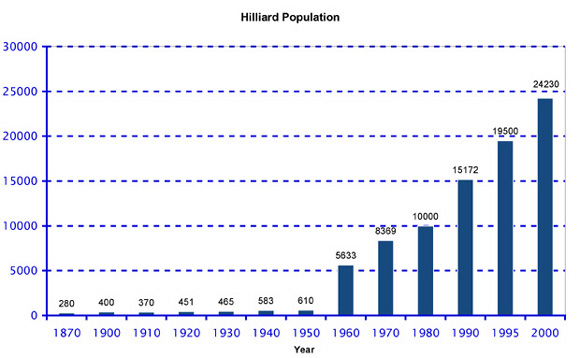Hilliard, Ohio
History of Hilliard
Hilliard was formed in 1853 by John Reed Hilliard who was a resident of Piqua. He purchased two (2) pieces of land in Norwich Township outside of Columbus for development. Originally called "Hilliard's Station," the village was established to take advantage of the new Columbus, Piqua and Indiana Railroad which was planned to pass through this area from Columbus and continue west. Hilliard laid out 200 lots in a grid pattern parallel to the railroad. And although, John Reed Hilliard created the map and plan for Hilliard’s Station, he never actually lived here.
In 1854, a post office was established in Hilliard’s Station and the word Station was dropped from the town name. The Village of Hilliard became incorporated on July 13, 1869 with a population of 280 residents, an increase of about 200 from 1860. Incorporated means that the village became an official town with its own charter (a description of the town’s rights, privileges and functions.)
The economy of Hilliard was dependent in its early years upon farming which took place on the land surrounding the Village. Because the village was so close to Columbus (10 miles), the railroad brought some large commercial and industrial development to Hilliard. Among the earliest businesses in the Village were a warehouse built by John Hilliard in 1853 and a steam saw mill built by Ralston and Kirkpatrick in 1854. In 1892, a creamery was built on Columbia Street.
 Development of the residential lots in Hilliard started very slowly, but appears to have been steady as the Village developed into the late 1800s and early 1900s. While the majority of the residents were engaged in farming, many others worked in the schools, churches, or businesses established in the community. By 1872, the greatest concentration of houses was located on Main and Center Streets, with a scattering on the side streets of Norwich, Wayne and Columbia.
Development of the residential lots in Hilliard started very slowly, but appears to have been steady as the Village developed into the late 1800s and early 1900s. While the majority of the residents were engaged in farming, many others worked in the schools, churches, or businesses established in the community. By 1872, the greatest concentration of houses was located on Main and Center Streets, with a scattering on the side streets of Norwich, Wayne and Columbia.
Laid out perpendicular to the railroad, Main Street was established from an early date as the primary road in the community. The 1872 Atlas of Hilliard shows Main Street as the location of the Union School, two (2) community churches, a hotel, and several commercial buildings, along with a number of homes. The location of a hotel (Hotel Franklin) near the railroad was designed to provide lodging for salesmen and other passengers traveling through Hilliard.
Businesses
Commercial buildings were frequently constructed next to house businesses on the ground floor and halls for the use of fraternal organizations on the upper story. A one-story commercial building built prior to 1872 and owned by John Westerweller was converted to a two-story commercial structure by the 1oca1 chapter of Masons which used the upper floor as a masonic hall. Two (2) of Main Street's most important 19th century commercial buildings, the Winterringer Building (c. 1870) and the Odd Fellows Hall (1883), both accommodated fraternal organizations on the upper floors. A fraternal organization is a group of people who meet and have common interests.
The first local utility in Hilliard was established in 1915 with the incorporation of the Hilliard Power and Light Company, although its capacity was somewhat limited.
The early 20th century also brought the relocation of the Fishinger Flour Mill to Hilliard around 1915, the establishment of a lumber company next to the railroad in 1916, and the construction of a grain elevator by Riddle and Wood near the railroad in 1917. A coal company was also located in Hilliard at this time. The railroad, now operated by the Panhandle Railroad, continued to transport passengers and freight, with two round trips each day to Columbus and points west. Hilliard’s Station, originally located on Center Street, accommodated passengers until 1944 and freight until 1962 when it was closed by the railroad. After 1962, the depot was relocated (moved) to Weaver Park by the Northwest Franklin County Historical Society.
Growth
Between 1900 and the 1929, a concentration of residential development along Norwich Street from Columbia to Hilliard-Cemetery Road occurred. Construction of new homes and businesses in the Village of Hilliard slowed during the Depression through World War II.
 The slow, but steady growth of Hilliard over a 100 year period was dramatically changed during the 1950s and 60s when the town’s size grew tremendously. In 1950, Hilliard was still a village, with a population of only 610. In 1960, the population of Hilliard had increased to 5,633, enabling the community to be designated a city. By late 1967, Hilliard had more than doubled its 1960 land area through annexation.
The slow, but steady growth of Hilliard over a 100 year period was dramatically changed during the 1950s and 60s when the town’s size grew tremendously. In 1950, Hilliard was still a village, with a population of only 610. In 1960, the population of Hilliard had increased to 5,633, enabling the community to be designated a city. By late 1967, Hilliard had more than doubled its 1960 land area through annexation.
Population
The Village of Hilliard gained city status officially from the Secretary of State of Ohio, by attaining a population of 5,633 on December 12, 1960. With the completion of the I-270 outerbelt a second wave of fast growth came to the area in the 1980s. That growth continues into the 2000s at a rapid rate. The 2000 US Census reports that the City of Hilliard is home to 24,230 people.

US Census Map of Population Density for Hilliard
Government
The City of Hilliard by City Charter has the Mayor-Council Plan of government.
A city is a unique government entity with its own special charter. Cities are not subdivided, except into neighborhoods which are informal geographic areas.
Hilliard’s city charter is known as the Mayor-Council Plan. The legislative powers of the city are assigned to a Council of seven members, elected at large, for four overlapping terms.
Interesting Facts
John Reed Hilliard never actually lived in Hilliard.
The first train depot in Hilliard’s Station was three boxcars set together.
Even after the word Station was dropped from the name, many people continued to call the area Hilliards until it became a city in 1960.
More Information & Primary Sources
- City Council
- Mayor and Directors
- Certificate of Election 1933
- Hilliard Aerial 1951 1
- Hilliard Aerial 1951 2
- Hilliard Aerial 1951 3
- Main Street North 1913
- Main Street North 2002
- Main Street South 2002
- Street Light
- Primary
- Articles
- Image
- Charts
- Artifact
- Link
- Map
References:
Historic Development of Hilliard, 1986
City of Hilliard

